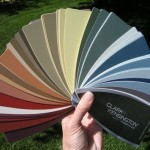Best Colour to Paint a Timber Fence: A Comprehensive Guide
Selecting the optimal colour for a timber fence involves a complex decision-making process that considers several factors. These factors encompass aesthetic preferences, environmental impact, maintenance requirements, and the overall design of the property. The chosen colour can significantly influence not only the visual appeal of the fence but also its longevity and integration within the surrounding landscape.
The decision of what colour to paint a timber fence is not merely a cosmetic one. It impacts the lifespan of the wood, the perceived size of the yard, and the curb appeal of the entire property. This article aims to provide a comprehensive exploration of the key considerations involved in choosing the best colour for a timber fence.
Understanding the Impact of Colour on Timber
The colour of paint used on timber has a direct bearing on the wood's interaction with environmental elements, particularly sunlight. Darker colours absorb more solar radiation, leading to higher surface temperatures. This increased heat absorption can accelerate the expansion and contraction cycles of the wood, potentially causing cracking, warping, and ultimately, reducing the fence's lifespan. Conversely, lighter colours reflect more sunlight, mitigating the effects of heat absorption. However, very light colours may show dirt and mildew more readily.
Furthermore, the chemical composition of different pigments can also affect timber degradation. Certain pigments may be more susceptible to fading or breakdown under UV exposure, requiring more frequent repainting. Therefore, selecting a high-quality paint with UV-resistant pigments is crucial for long-term durability, regardless of the colour chosen.
The type of timber used for the fence also influences how it interacts with paint. Certain wood species are more porous than others, affecting paint absorption and the necessary number of coats. For example, treated pine often requires a primer to ensure proper paint adhesion due to its smooth surface. The natural colour of the timber can also influence how the final painted colour appears. The existing wood tone might slightly alter the perceived hue of the paint, especially with lighter colour options.
Key Colour Considerations for Timber Fences
Several key factors warrant consideration when selecting a paint colour for a timber fence. These include the aesthetic goals of the homeowner, the architectural style of the house, the surrounding landscape, and the maintenance requirements associated with different colours.
Neutral colours such as white, gray, and beige are popular choices due to their versatility and ability to complement a wide range of architectural styles. White fences offer a clean and classic look, but they require more frequent cleaning to maintain their pristine appearance. Gray and beige offer a more forgiving alternative, concealing dirt and mildew while providing a subtle backdrop for landscaping. Darker colours like black or deep brown can create a more dramatic and modern look, but they are more prone to fading and heat absorption, requiring more frequent maintenance.
The fence colour should ideally complement the architectural style of the house. For example, a white picket fence might be well-suited for a traditional Victorian home, while a dark gray fence might be more appropriate for a contemporary modern residence. It is also important to consider the colour of the house's trim, siding, and roof to ensure a cohesive and harmonious overall aesthetic.
The surrounding landscape plays a vital role in determining the best fence colour. A fence colour that blends in with the natural environment can create a sense of continuity and spaciousness. Earthy tones such as browns, greens, and grays can be particularly effective in achieving this effect. Alternatively, a fence colour that contrasts with the landscape can create a visual focal point and add interest to the yard. However, it's important to avoid choosing a colour that clashes with the surrounding vegetation or detracts from the natural beauty of the landscape.
Maintenance requirements are another crucial consideration. Darker colours tend to show fading and chalking more readily than lighter colours, requiring more frequent repainting. Lighter colours, on the other hand, may show dirt, mildew, and stains more easily, necessitating more frequent cleaning. Ultimately, the chosen colour should be compatible with the homeowner's willingness to perform regular maintenance to keep the fence looking its best.
Popular Colour Choices and Their Implications
Understanding the specific pros and cons of popular colour choices can facilitate a more informed decision-making process. Some commonly chosen colours for timber fences are discussed below:
White:
White fences are classic and create a clean, bright aesthetic. They enhance the perceived size of a yard and provide a stark contrast to greenery, making plants stand out. However, white fences require frequent cleaning to prevent mildew and dirt buildup, especially in humid climates. They are also easily stained and can show imperfections more readily than other colours. The reflection of sunlight off white surfaces can also be intense during certain times of the day.Gray:
Gray fences are versatile and contemporary. They offer a neutral backdrop that complements a wide range of architectural styles and landscaping designs. Gray is also more forgiving than white, concealing dirt and mildew more effectively. Various shades of gray are available, from light and airy to dark and dramatic. Darker grays, however, may still suffer from heat absorption to a certain degree.Brown:
Brown fences blend seamlessly with natural surroundings, creating a sense of harmony with the landscape. Earthy brown tones provide a warm and inviting feel. Different shades of brown can evoke different moods, ranging from rustic to sophisticated. Brown is also relatively low-maintenance, concealing dirt and weathering well. However, certain brown pigments may be prone to fading over time, particularly those containing iron oxide.Black:
Black fences create a bold and modern statement. They provide a strong visual contrast and can make a yard feel more enclosed and private. Black is also effective at concealing imperfections and dirt. However, black fences absorb a significant amount of heat, which can lead to accelerated wood degradation. They are also more prone to fading and chalking than lighter colours. Furthermore, black can appear quite stark and overwhelming in smaller yards or against lighter-coloured homes.Green:
Green fences blend organically with the surrounding foliage, making them an excellent choice for creating a natural and unobtrusive boundary. Green is a calming and soothing colour that promotes a sense of tranquility. However, it is important to choose a shade of green that complements the existing vegetation. A green that is too bright or artificial can clash with the natural environment. Additionally, some green pigments may be more susceptible to fading than others.Beyond these basic colours, a wide range of hues and shades can be used to achieve a desired aesthetic. Consulting with a professional paint specialist or landscape designer can be beneficial in determining the best colour for a specific property and design goals. They can provide expert advice on colour matching, paint types, and application techniques.
Regardless of the chosen colour, it is essential to use a high-quality exterior paint specifically formulated for timber. These paints typically contain UV inhibitors and mildewcides to protect the wood from the elements and prolong its lifespan. Proper surface preparation, including cleaning, sanding, and priming, is also crucial for ensuring optimal paint adhesion and durability.

Fence Paint Color Ideas To Boost Curb Appeal Wow 1 Day Painting

Fence Painting Ideas That Will Make The Difference

Choosing The Right Colour For Your Fence Makeovers

14 Best Backyard Fence Color Ideas For Stain Or Paint

Top 10 Wonderful Timber Fence Colors For 2025 Pentagon

Do S And Don Ts For Choosing The Right Fence Colour Maria Killam

Top 10 Wonderful Timber Fence Colors For 2025 Pentagon

Fence Painting Ideas That Will Make The Difference

Choosing The Right Colour For Your Fence Makeovers

Do S And Don Ts For Choosing The Right Fence Colour Maria Killam
Related Posts








